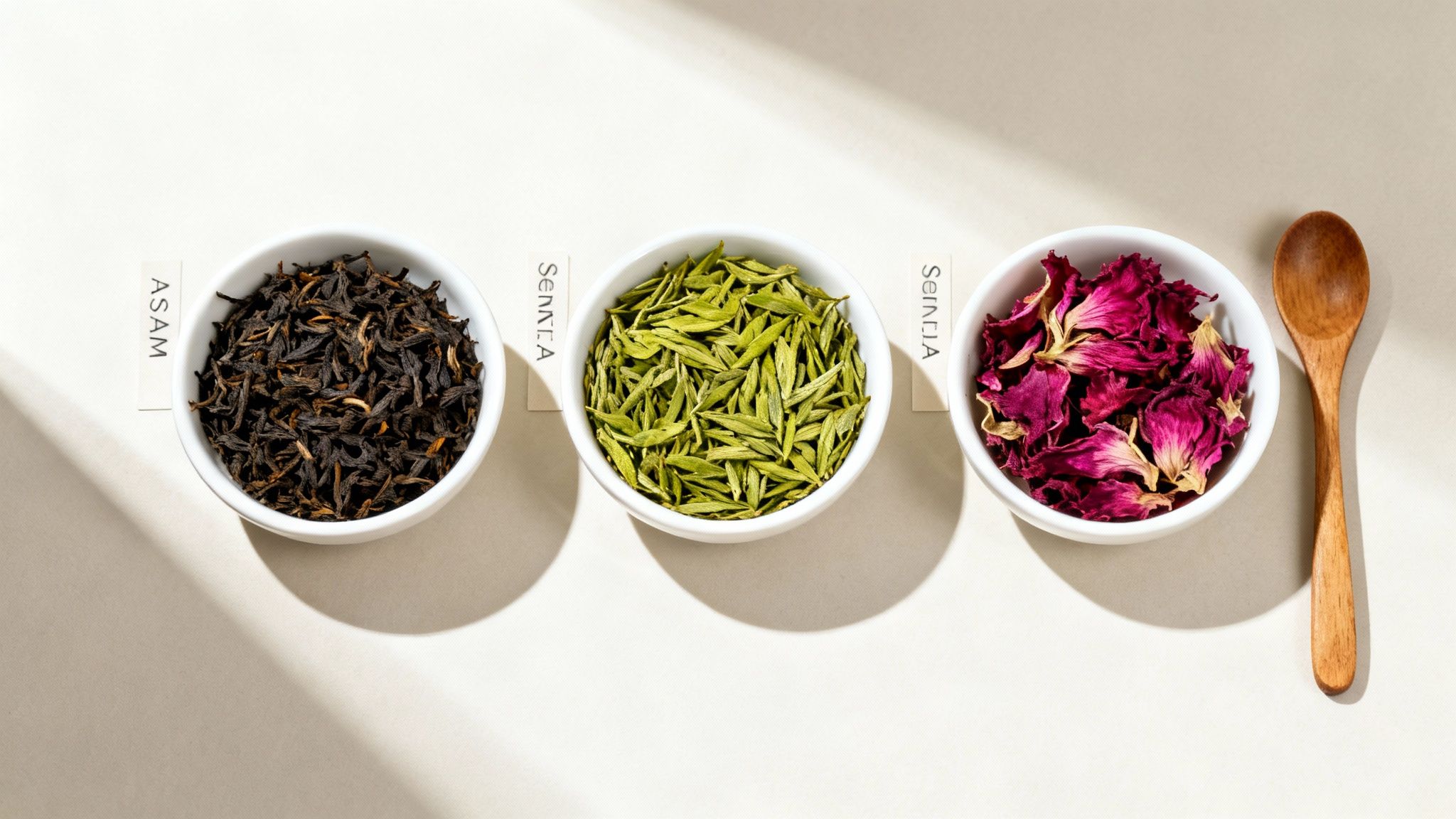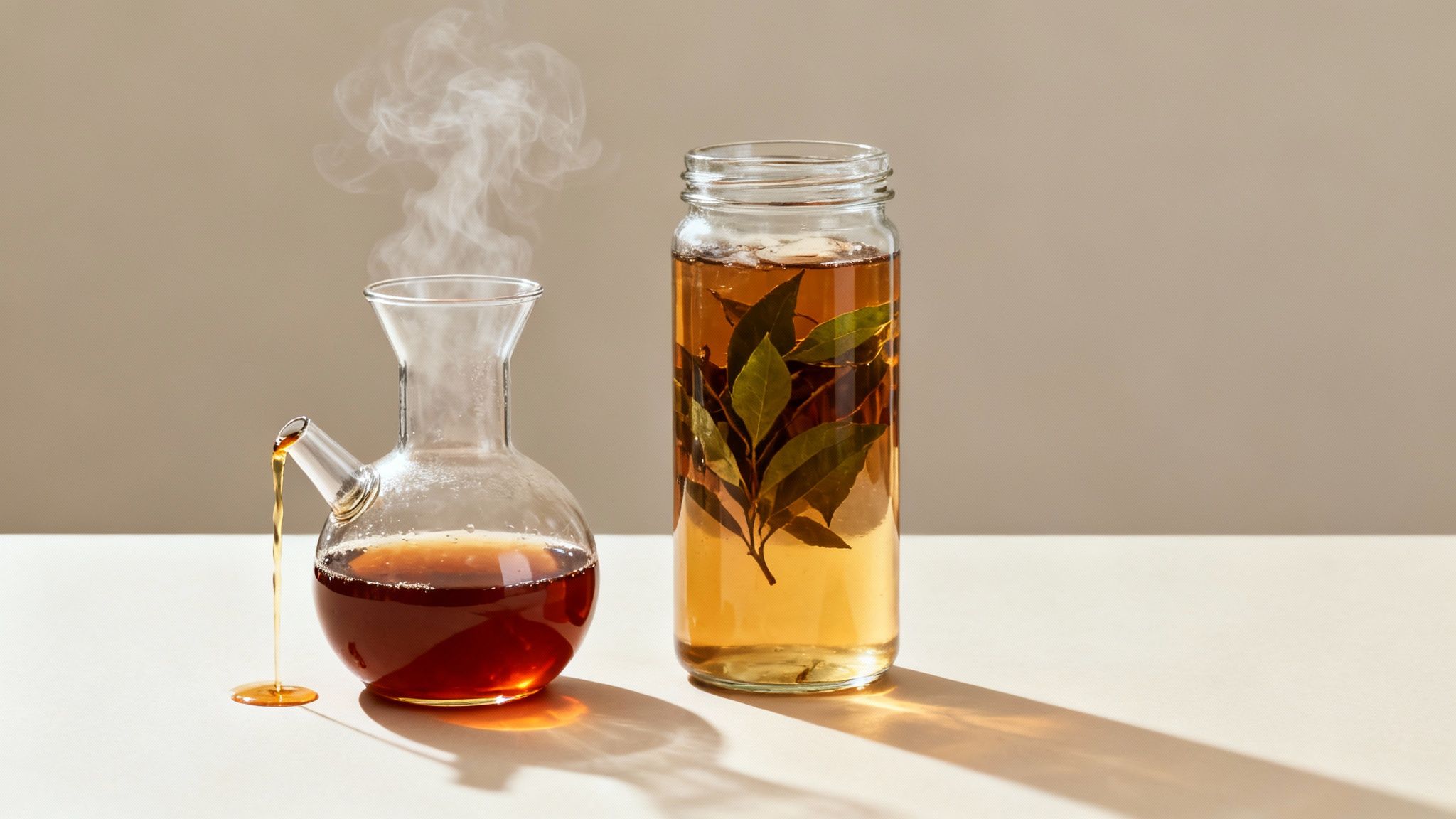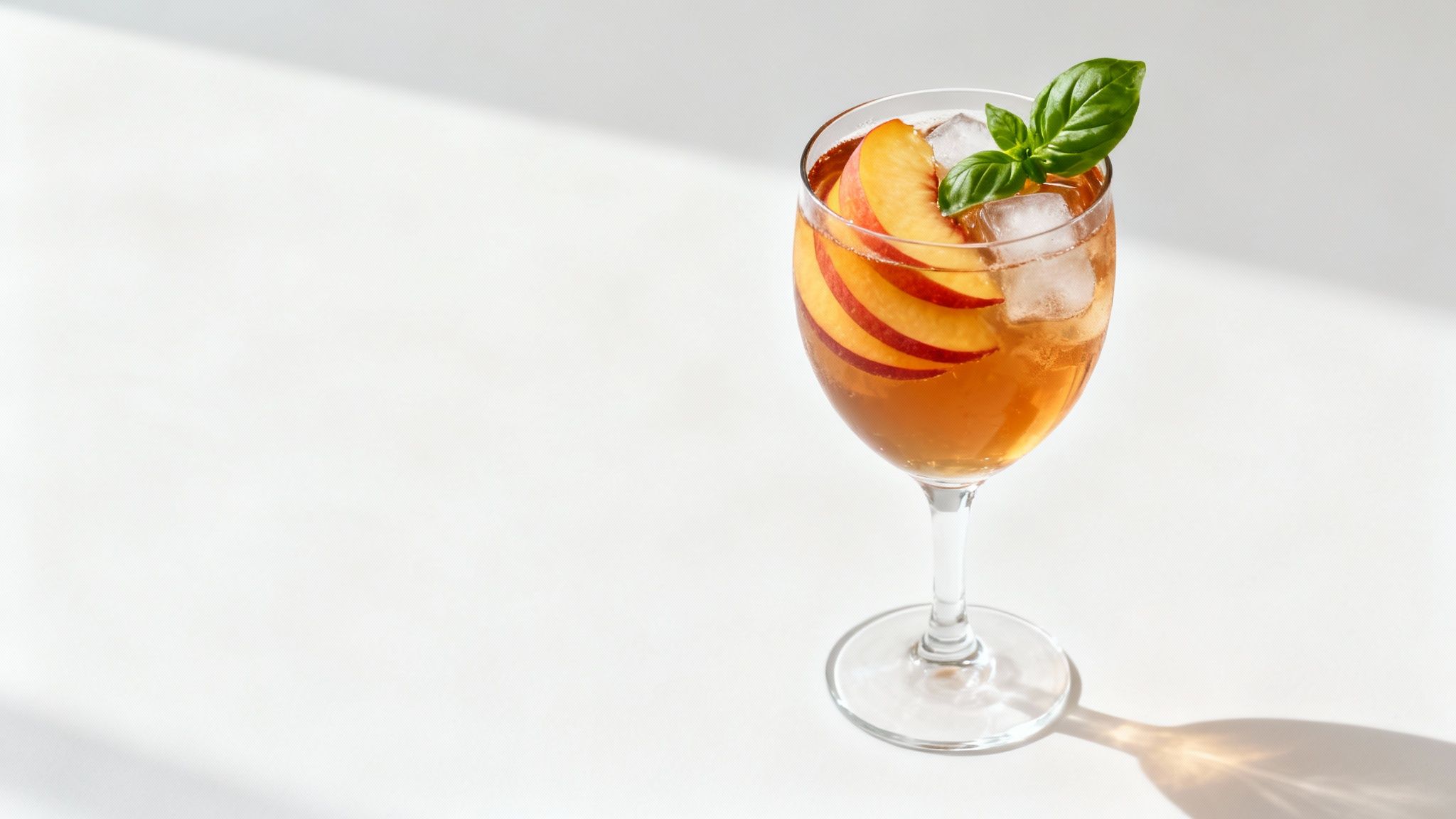Learning how to make proper iced tea at home is deceptively simple: just brew a strong tea, let it cool, and pour it over ice. But that basic method is your gateway to a world of flavour that you just can't get from a bottle. It's all about taking control of the sweetness, the ingredients, and crafting your perfect summer drink.
Beyond the Bottle: Why Homemade Iced Tea Wins

Forget those overly sweet, one-note iced teas from the supermarket. This guide is about reclaiming a summer classic and making it entirely your own. When you step away from the pre-packaged stuff, you get complete control over what goes into your glass—a big reason why so many people are rediscovering this simple craft.
It’s more than just a drink; it's about choosing real ingredients and playing with flavours you’ll never find on a shelf. This isn't just a recipe, it's about a better way of doing things—tapping into a desire for wellness, creativity, and a bit of DIY pride.
The Superiority of Freshly Brewed
The difference between homemade and shop-bought iced tea is night and day. Honestly. When you brew your own, you unlock a few key advantages that completely elevate the experience.
- Flavour Control: You're in charge. You decide how strong the brew is, what kind of tea to use, and exactly how sweet (or not sweet) it is. Every glass is made just for you.
- Ingredient Quality: Say goodbye to artificial flavours and preservatives. You can use beautiful loose-leaf teas, fresh fruit, and natural sweeteners.
- Cost-Effectiveness: Making a big pitcher at home is far cheaper than buying individual bottles. It’s better value without ever compromising on quality.
Making your own iced tea is wonderfully empowering. It puts you in charge of your refreshment, transforming a simple beverage into a personalised creation that reflects your taste and values.
Iced tea's popularity here in the UK just keeps growing, especially when the sun makes an appearance. In fact, 62% of 18 to 24-year-olds drink iced tea, showing just how much it resonates with younger generations looking for refreshing alternatives.
This shift towards custom drinks isn't just happening in our kitchens, either. If you're curious about how the professionals create consistently brilliant drinks on a much bigger scale, you can explore the world of commercial beverage equipment to see the machinery behind the craft.
Choosing the Right Tea for Your Brew

The secret to a truly unforgettable iced tea? It all starts with the leaves. Getting this first step right is what separates a decent cold drink from a genuinely refreshing, flavourful brew. It's time to look beyond the generic "black tea" box.
If you’re after that classic, robust iced tea flavour, a good quality black tea is your best friend. Think of something with a bit of backbone, like a malty Assam or a bold English Breakfast. These teas have enough character to hold their own when chilled, and they won't get lost if you decide to add a slice of lemon or a touch of sugar.
For something a little more delicate, a floral Darjeeling makes a beautiful iced tea, though it's worth remembering that different teas have varying levels of tannins. These are the compounds that can sometimes make a brew turn bitter or cloudy when cooled down too quickly. I've found that using high-quality loose-leaf tea often gives a smoother, more complex result, as the larger leaves release their flavour more gently.
Exploring Beyond Black Tea
Don’t feel boxed in by black tea, though. Some of the most exciting iced teas I’ve made have come from experimenting with green teas and herbal infusions. Each one brings something completely different to the table.
- Green Teas: A grassy Japanese Sencha or a subtly smoky Gunpowder green tea creates an incredibly crisp, clean-tasting brew. These are particularly good for cold brewing, as this gentle method sidesteps any risk of bitterness.
- Herbal Infusions: Here’s where you can really get creative, especially if you want a caffeine-free option. Tart hibiscus brews up a stunning deep-red drink, while peppermint is naturally cooling and perfect for a sweltering day. Another favourite of mine is Rooibos, which has a lovely earthy sweetness.
Choosing your tea is like choosing your paint colour—the base determines the entire character of the final piece. A bold black tea creates a classic canvas, while a vibrant herbal infusion starts you off with a splash of unexpected colour.
To help you get started, here's a quick rundown of some popular choices for iced tea.
Your Guide to Iced Tea Varieties
| Tea Type | Flavour Profile | Caffeine Level | Best For |
|---|---|---|---|
| Black Tea | Bold, malty, brisk | High | A classic, robust iced tea that stands up to milk, lemon, or sugar. |
| Green Tea | Grassy, vegetal, light | Medium | A crisp and refreshing brew, especially when cold-brewed to avoid bitterness. |
| White Tea | Delicate, floral, subtle | Low | A very light and nuanced iced tea for those who prefer delicate flavours. |
| Herbal | Varied (fruity, minty, spicy) | Caffeine-Free | Creating vibrant, flavourful, and caffeine-free drinks. Endless possibilities! |
Ultimately, the best tea is simply the one you enjoy most. Don’t be afraid to try a few different things to find what you love. If you want to dive a bit deeper, learning about the different types of tea and their unique qualities is a great way to start crafting your perfect iced tea from the ground up.
Mastering the Two Core Brewing Methods

This is where the real magic happens. When it comes down to it, making brilliant iced tea at home involves one of two simple approaches: the speedy hot brew method or the laid-back cold brew method. Which one you choose really just depends on how much time you've got and the kind of flavour you're after.
The hot brew is your go-to when you're short on time. It’s all about creating a potent tea concentrate that you then cool down and dilute. Perfect for when you need a refreshing glass in under an hour. On the other hand, the cold brew method is a slow, almost effortless infusion that rewards your patience with an incredibly smooth, naturally sweet tea.
Let's get into how to perfect both.
The Quick Hot Brew Concentrate Method
If you want delicious iced tea and you want it now (or soon!), the hot brew concentrate technique is your best friend. The basic idea is to brew a double-strength tea with hot water, which pulls out all the flavour nice and quick. You’ll want to use about twice the amount of tea leaves you’d normally use for a hot cuppa.
Once it's steeped, you simply dilute this punchy concentrate with the same amount of cold water before pouring it over a glass packed with ice. Now, this quick-chill can sometimes make your tea go cloudy, especially with bolder black teas. The trick I've learned is to let the hot concentrate cool to room temperature on the side before you even think about putting it in the fridge. This simple pause helps stop the tannins from clumping together and spoiling the look of your beautiful brew.
The secret to a crystal-clear hot-brewed iced tea is patience during the cooling phase. Rushing it straight into the fridge is the number one cause of cloudiness. Just let it sit on the counter first.
The Effortless Cold Brew Method
For what is, in my opinion, the smoothest iced tea you’ll ever taste, you have to try cold brewing. This technique is simplicity itself. It produces a drink with practically zero bitterness because the cold water coaxes the flavour from the leaves far more gently than hot water ever could.
All you have to do is pop your loose-leaf tea or tea bags into a large pitcher with cold, filtered water, and leave it to do its thing in the fridge. The steeping time varies from 6 to 12 hours, depending on the tea and how strong you like it. A delicate white tea might only need 6 hours, while a robust rooibos or herbal blend could happily sit for the full 12. If you want to dive deeper into the basics, you can brush up on how to brew loose-leaf tea in more detail.
Whichever method you pick, remember that great iced tea starts with pure water; using a domestic water purifier can make a real difference. The cold brew method is so gentle that it's also incredibly forgiving, making it a fantastic, foolproof place to start your home-brewing journey.
Elevating Your Iced Tea with Flavour

Once your tea is brewed and chilled, the real fun begins. This is your chance to move beyond a simple pitcher of tea and create something truly special – a sophisticated drink that rivals anything you’d find in a high-end café.
Most of us reach for sugar first, but trying to stir granulated sugar into cold liquid is a shortcut to disappointment. You'll inevitably end up with a gritty sludge at the bottom of the glass. The professional approach is to use a liquid sweetener.
A simple syrup is the gold standard for a reason. Just gently heat equal parts water and sugar until it all dissolves, then let it cool. It mixes into cold tea seamlessly, giving you consistent sweetness in every single sip.
Better yet, you can use this syrup as your first layer of flavour. While it's cooling, why not toss in a split vanilla bean, a few slices of fresh ginger, or some crushed cardamom pods? It’s an easy way to add a subtle complexity. Natural alternatives like honey and agave nectar also work beautifully, each lending its own distinct character to the final drink.
Infusing with Fresh Ingredients
Now, let's build on that foundation with fresh ingredients. This is less about following a rigid recipe and more about playing with combinations to see what you love. The secret is to find flavours that complement your tea base, not steamroll over it.
Here are a few combinations that I always come back to:
- For Black Tea: The bold, malty character of black tea stands up well to robust fruit. Try muddling a few fresh peach slices with a handful of basil leaves at the bottom of the pitcher before you pour in the tea.
- For Green Tea: Those crisp, almost grassy notes of a good green tea are just begging for something cooling. Slices of cucumber and a generous sprig of fresh mint create a drink that is pure refreshment.
- For Herbal Tea: With a naturally caffeine-free base like rooibos, I love to lean into warm spices. A cinnamon stick and a long curl of orange peel left to infuse in the pitcher add a wonderfully comforting aroma.
Think of your brewed tea as the canvas. The fresh fruit, herbs, and spices you add are the colours you use to paint your masterpiece. Start with a little, taste, and add more until it's just right.
The Growing Appeal of Custom Drinks
This desire for unique, flavourful drinks isn't just a home-brewing trend; it's happening everywhere. The UK's ready-to-drink tea market is set to hit USD 928.84 million by 2033, a boom driven by our collective thirst for interesting, low-calorie options like flavoured green and herbal teas. By making your own, you're tapping directly into this move towards more personalised, healthier beverages.
Fresh mint, in particular, is a fantastic ingredient to have on hand. If you enjoy its bright, cooling kick, you'll find plenty of inspiration in our guide to making refreshing mojito mint mocktails, which uses many of the same flavour-building techniques we've talked about here.
Finishing Touches: Serving and Storing
You’ve brewed the perfect batch, but the final touches are what elevate a simple iced tea into something special. How you serve and store it makes all the difference, keeping every glass as vibrant and refreshing as the first.
When it's time to pour, don't be shy with the ice. A full glass is essential to chill the tea instantly without diluting that beautiful flavour you worked so hard to create. A simple garnish, like a sprig of fresh mint or a bright wheel of lemon, really lifts the whole experience.
Keeping Your Tea at its Best
Now, for storage. This might sound fussy, but your choice of container is more important than you’d think. Always reach for a sealed glass pitcher or jar. Plastic is a no-go – it's porous and has a nasty habit of picking up other odours from the fridge, which can completely ruin the delicate taste of your tea.
Trust us on this: a glass container is non-negotiable. It’s the only way to guarantee your brew tastes purely of tea, not of last night’s curry.
Stored properly in a sealed glass container in the fridge, your homemade iced tea will keep beautifully for up to four days. It’s no wonder it’s so popular in UK cafés, where iced tea holds an 11% share of menu items – we clearly love a proper chilled brew. You can read more about UK iced tea trends here.
A Few Common Questions
Even the most seasoned tea brewers run into a few snags now and then. We've put together answers to the questions we hear most often, helping you get that perfect, refreshing pitcher every time.
Why Has My Iced Tea Gone Cloudy?
Ah, the dreaded cloudy tea. It’s a common sight but thankfully, an easy fix. Cloudiness happens when the natural tannins in tea (especially strong black teas) clump together as the hot brew is cooled down too quickly.
The simple solution? Patience. Just let your hot tea concentrate cool down on the worktop to room temperature before you put it in the fridge. This gentle cooling prevents the shock that causes those tannins to bind, keeping your tea beautifully clear.
If you want guaranteed crystal-clear iced tea, the cold brew method is your best bet. It’s a much slower, gentler infusion that doesn’t agitate the tannins, resulting in an exceptionally smooth and never-cloudy brew.
Can I Use Tea Bags Instead of Loose Leaf?
Of course! While we’re partial to the nuanced flavours you get from loose-leaf tea, a good quality tea bag can make a brilliant glass of iced tea. Don't feel like you're missing out if you prefer the convenience.
A good rule of thumb is to use one tea bag for every cup of water. So, for a standard 2-litre pitcher, you’ll be looking at around 6 to 8 tea bags. Just make sure you stick to the steeping times on the box to dodge any bitterness.
What's the Best Way to Sweeten Cold Tea?
Trying to stir granulated sugar into cold tea is a losing battle—you'll just end up with a gritty sludge at the bottom of your glass. The secret is to use a sweetener that's already in liquid form.
A simple syrup is your best friend here. Just gently warm up equal parts sugar and water in a pan until the sugar completely dissolves. Let it cool, and then you can stir it into your iced tea to taste. Honey, agave nectar, or maple syrup also work a treat.
Ready to put it all into practice? At Jeeves & Jericho, we source exceptional whole leaf teas that are perfect for creating stunning homemade iced tea. Explore our collection today and find your new favourite blend.


